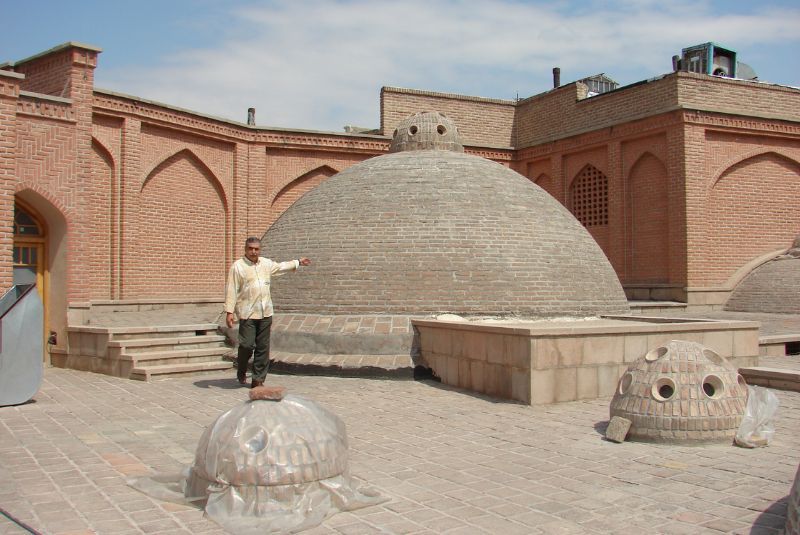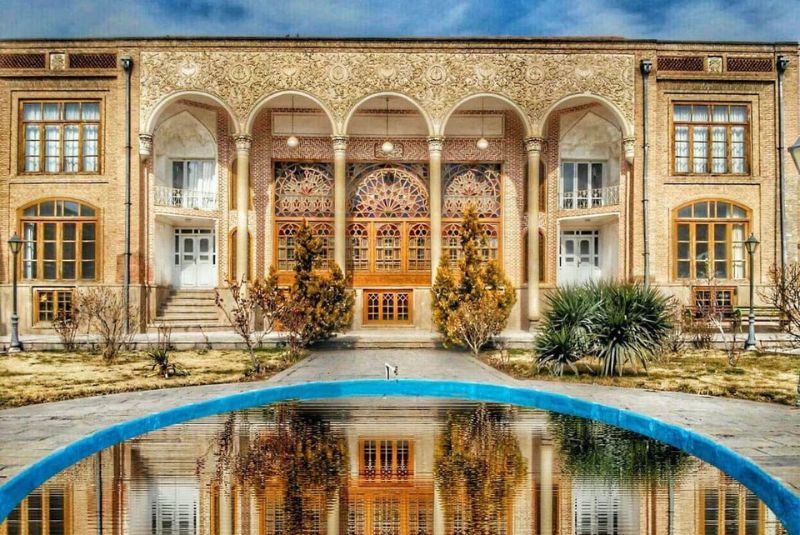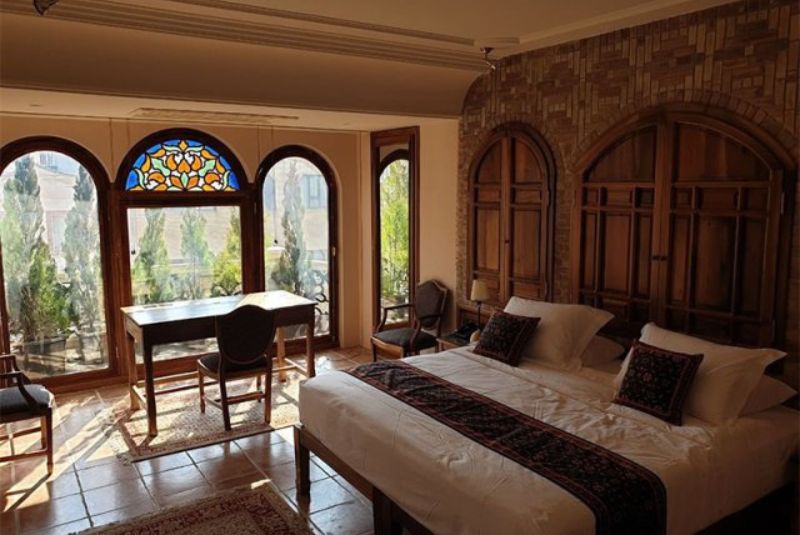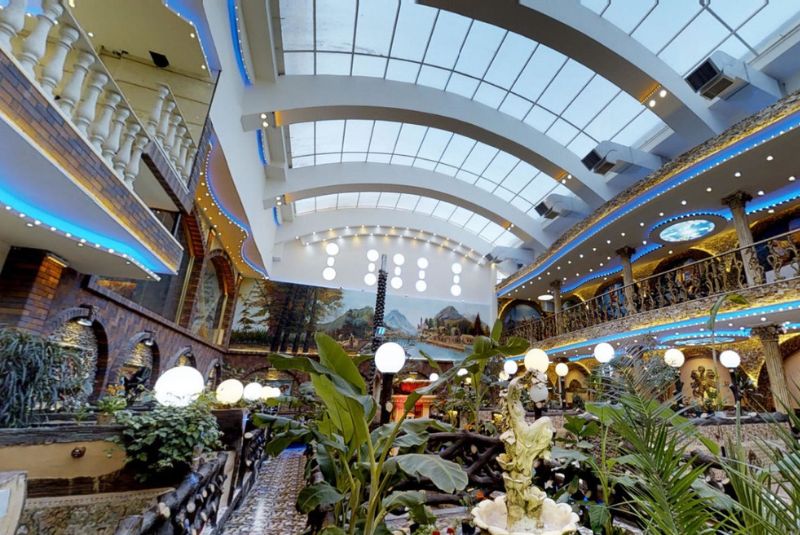Tabriz Nobar Bathhouse | A Qajar-era Hammam/Restaurant
Nestled in the heart of the city near the old Nobar Gate, the Nobar bathhouse was constructed in the late Qajar era and served as a bustling public bath until 1994. Spanning approximately 700 square meters, the Nobar Bathhouse was registered as Iran's National Heritage in 1999.
Its intricate design features the classic layout of Iranian baths: a narrow passage, a Sar-beena (dressing area), a heating center, a water pool, and a Garm-Khaneh (washing section), all adorned with intricate brick and tile work. Notably, it also housed private rooms known as Shah-neshin for the royal family.
After years of neglect, the Cultural Heritage Organization of East Azerbaijan Province undertook a meticulous six-year restoration project. Today, Nobar Bathhouse has been transformed into a charming traditional restaurant and tea house. Visitors can now enjoy local kebabs and sweets upstairs, while the downstairs tea house offers a cozy ambiance. Stay with us to learn more about this historic gem.
Why Visit Nobar Bathhouse in Tabriz?
- Nobar Bathhouse, also known as the Shahrayar Restaurant, is a key Qajar-era monument, officially registered as a national heritage site in 1999.
- It is the largest traditional restaurant in Tabriz, showcasing stunning Qajar architecture and providing an immersive glimpse into the past.
- Visiting Nobar Bathhouse offers not only architectural marvels but also a serene and relaxing atmosphere, making it a standout cultural attraction in the city.
About Nobar Hammam in Tabriz

Nobar Bathhouse is one of the most magnificent examples of early Qajar architecture, shining brightly in the historic city of Tabriz. Located at the intersection of Imam Khomeini Street and Tahrir Street, this splendid bathhouse spans approximately 700 square meters. It now serves as a traditional restaurant, attracting numerous visitors.
Public baths have a long history in Iran, dating back to the Ilkhanid period. These baths, often built alongside caravanserais and city gates. However, the devastating earthquakes that struck Tabriz led to the destruction of many of these structures.
As a result, the surviving historic baths in Tabriz date back primarily to the Qajar era. The destruction led to the construction of a new wall around Tabriz, featuring 8 to 12 gates, with new baths constructed near these gates.
Historical documents and maps suggest that Nobar Bathhouse, once located beside the Nobar Gate, dates back around 150 years. As Tabriz expanded and the old gate disappeared, the bathhouse found itself in the city's central area.
One of the most striking features of Nobar Bathhouse is its stone columns, which attract architecture students and art enthusiasts. The octagonal hall, adorned with traditional Qajar cushions around the pool, adds to its aesthetic appeal.
After years of damage from moisture and other factors, the bathhouse underwent restorations and, in 1999, was converted into a traditional restaurant. Today, it remains a top destination for its historical architecture.
The bathhouse’s spaces have been thoughtfully repurposed: the Sar-beena and Garm-Khaneh areas now function as dining areas, while the rooftop serves as a tea house and venue for traditional performances. As the largest and first traditional restaurant in Tabriz, Nobar Bathhouse is also a registered national heritage site.
Nobar Hamma in Tabriz History

The history of Nobar Bathhouse is deeply intertwined with the architectural evolution of Tabriz. During the Ilkhanid period, numerous public baths were constructed across Tabriz and other nearby cities, reflecting a broader trend of public infrastructure development.
However, many of these early baths were destroyed due to factors such as humidity, heat, and a devastating earthquake in 1785 CE, which led to the destruction of numerous key buildings. Following this calamity, a new city wall with 8 to 12 gates was constructed around Tabriz, and new baths were likely built near these gates as per the previous tradition.
Nobar Bathhouse, as one of the remaining historical examples, dates back to the Qajar era. Historical documents and maps reveal that the bathhouse is approximately 140 years old.
For instance, a map of Tabriz from before 1864 CE shows the bathhouse near Nobar Gate, while another notable map from 1918 CE lists the structure as "Bath of the Minister."
As Tabriz expanded and the old gates were demolished, the Nobar Bathhouse was relocated to the city center. The bathhouse was designed by the renowned architect Balakazem from Qara Aghaj, showcasing the blend of historical and architectural significance that characterizes this enduring landmark.
Function of Nobar Bathhouse

Originally used as a bathhouse, Nobar Bathhouse suffered significant damage over the years due to its location and moisture issues. It underwent several restorations by the Cultural Heritage Organization.
In 1999, after being listed as a national heritage site, it was repurposed as a traditional restaurant, known as the first and largest of its kind in Tabriz. The transformation preserved the building's historical integrity while adapting it for new use. The rooftop was utilized for a tea house and traditional performances.
Architecture of Nobar Bathhouse

Nobar Bathhouse, designed by the renowned architect Balakazem from Qara Aghaj, stands as a prime example of Qajar-era architecture. Constructed with materials like mortar, brick, and plaster in the walls and ceilings, and carved stone for the columns, floors, and bases, this bathhouse is celebrated for its intricate and aesthetically pleasing design.
General Design
The bathhouse features a blend of geometric shapes that contribute to its unique architectural charm. The structure is divided into two main sections: the Sar-beena (changing room) and the Garm-Khaneh (heated room).
Sar-beena (Changing Room)
The Sar-beena is a large, octagonal space with a vaulted ceiling supported by eight striking stone columns. At the center of this area is an octagonal pool, surrounded by raised seating. The stone columns and their intricately decorated capitals add a touch of elegance to this section.
Garm-Khaneh (Heated Room)
The Garm-Khaneh features a large vaulted dome, with a combination of brick and tilework that enhances its visual appeal. The main hall is supported by four central stone pillars and is covered by a grand central column.
The layout of this area is rectangular, transitioning from the Sar-beena to the Garm-Khaneh with an angled design. The central space of the Garm-Khaneh is square, featuring four octagonal pillars. Surrounding this central space are other parts of the heated room, which have been modified during recent restorations. It is believed that the northern part of the Garm-Khaneh originally housed the pools, with remnants of the bath's heating system still visible.

Central Rectangular Hall
A rectangular hall connects the Sarbina to the Garmkhaneh with changes in angle. The central part of the Garmkhaneh has a space with four octagonal columns. Despite recent restorations, the northern section of the Garmkhaneh likely housed the bathing pools.
Entrances
Nobar Bathhouse has two entrances from the surrounding streets:
- Main Entrance: Opens into a long corridor that leads to a shop and then to the Sar-beena.
- Secondary Entrance: Features a stairway and, like the main entrance, provides access to both the bathhouse and a café.
These entrances are positioned in three corners of the Sar-beena, creating an organized flow for entry and exit.
Nobar Bathhouse Location
Nobar Bathhouse is located in East Azerbaijan Province, Tabriz, at the intersection of Imam Khomeini Street and Tarbiat Street, directly opposite the Municipality Palace.
How to Get There
- Bus: To reach Nobar Bathhouse via public transport, take Bus Line 1 of the BRT (Bus Rapid Transit) system. Disembark at the Tarbiat Station, and you will need to walk a short distance to the bathhouse.
- Metro: The nearest metro station is Sa'at Square (Clock Tower). From there, you can walk towards Tarbiat Street to reach Nobar Bathhouse.
- Private Vehicle: If you are traveling by car, be aware that parking can be challenging due to the busy city center and limited parking spaces. It’s advisable to plan for possible parking issues in advance.
- Walking: If you are walking, head towards Tarbiat Street from Sa'at Square. Nobar Bathhouse is situated a short distance from the entrance of the Tarbiat Bazaar, on Ferdowsi Street.
Nearby Attractions to Nobar Hammam

- Arg-e Alishah: Just 450 meters from Nobar Hammam, this ancient citadel is a significant historical and architectural landmark in Tabriz.
- Behnam House: Located 650 meters away, this historical house offers a glimpse into traditional Persian residential architecture.
- Heydarzadeh House: At 700 meters, this elegant building showcases classic design elements typical of the region.
- Sanjesh Museum: Also 700 meters from Nobar Hammam, this museum provides insights into the historical measurement systems used in Tabriz.
- Nikdel House: Situated 850 meters from the bathhouse, this residence highlights local architectural styles and historical significance.
- Shahryar House: About one kilometer away, this site is dedicated to the renowned Persian poet Shahryar and offers cultural and historical context.
- Tabriz Municipality Palace: Located 1.7 kilometers from Nobar Hammam, this grand building features a clock tower and represents an important city landmark.
- Tabriz Historic Bazaar Complex: A UNESCO World Heritage site and one of the largest covered bazaars in the world, perfect for exploring local crafts and cuisine.
- Blue Mosque (Masjed-e Kabud): Known for its stunning blue tiles and intricate calligraphy, this historic mosque is a must-visit.
- El Goli Park: A large park with a historic mansion in the middle, ideal for relaxing walks and enjoying nature.
- Azerbaijan Museum: Offers a rich collection of historical artifacts, providing deeper insights into the region’s history and culture.
Hotels Near Nobar Bathhouse

- Sahand Hotel: Located just 350 meters from Nobar Bathhouse, Sahand Hotel offers a convenient and comfortable stay for visitors.
- Zhaleh Hotel: Approximately 500 meters from Nobar Bathhouse, Zhaleh Hotel provides a welcoming atmosphere and easy access to the local attractions.
- Sina Hotel: Situated 1.2 kilometers away, Sina Hotel is a well-regarded option with a range of amenities for a pleasant stay.
- Mervarid Hotel: Also 1.2 kilometers from Nobar Bathhouse, Mervarid Hotel offers comfortable accommodations and is a short distance from key sites.
- Sadaf Apartment Hotel: Located 1.7 kilometers away, Sadaf Apartment Hotel is ideal for those looking for a more home-like stay with self-catering options.
- Caspian Hotel: At a distance of 2.5 kilometers, Caspiyan Hotel provides a more extensive range of facilities for guests.
Restaurants Nearby

- Araz Pasha Restaurant: About 800 meters from Nobar Bathhouse, Araz Pasha offers a variety of traditional dishes in a cozy setting.
- Haj Majid Chelopez Restaurant: Located 1.1 kilometers away, Haj Majid specializes in delicious Persian rice dishes and offers a traditional dining experience.
- Golestan Restaurant:4 kilometers from the bathhouse, Golestan Restaurant is known for its rich menu and inviting atmosphere.
- Ipek Yolu International Restaurant: Situated 2.6 kilometers away, this restaurant offers international cuisine and a diverse menu in a refined setting.
- Shazde Restaurant: Located 2.8 kilometers from Nobar Bathhouse, Shazde Restaurant provides a luxurious dining experience with a variety of gourmet options.
- Majlesi Restaurant: 3 kilometers from the bathhouse, Majlesi Restaurant offers a high-quality dining experience with traditional Persian dishes.
Bottom Line
Nobar Bathhouse in Tabriz, a historic gem from the late Qajar era, is a must-visit for anyone interested in Iranian architectural heritage. Constructed near the old Nobar Gate and registered as a national heritage site in 1999, this 700-square-meter bathhouse features intricate brick and tile work, with classic elements like a Sar-beena (dressing area), a heating center, and a Garm-Khaneh (washing section). It also includes Shah-neshin rooms for the royal family.
After years of neglect, the bathhouse underwent a six-year restoration and now operates as the Nobar bath restaurant also known as Shahrayar Restaurant, offering a unique blend of historical ambiance and local cuisine. Guests can enjoy traditional kebabs and sweets upstairs, while the tea house below provides a cozy retreat. Nobar Bathhouse combines architectural splendor with a serene dining experience, making it a standout cultural attraction in Tabriz.
Share your story!
Comment below and let us know about your Experience.
Your story inspires others!


Comment
Leave a Comment